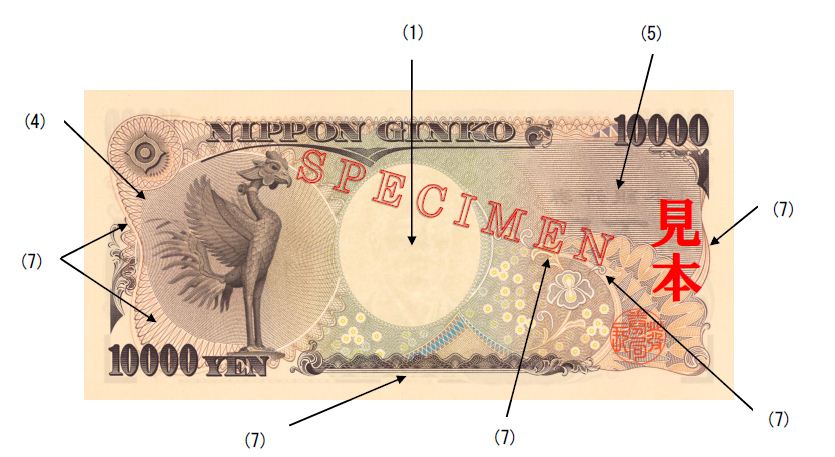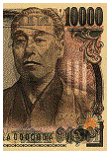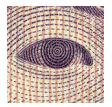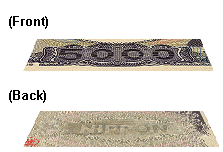Security Features of Bank of Japan Notes
October 31, 2019
Bank of Japan
Portraits placed on 10,000 yen note (Yukichi Fukuzawa), 5,000 yen note (Ichiyo Higuchi), and 1,000 yen note (Hideyo Noguchi).
10,000 yen note
Size: 76 x 160 mm
Date of first issue: Nov. 1, 2004

Front

Back
Details of the security features
-
(1) Watermark
- (2) Ultrafine-line printing
- (3) Hologram
When the banknote is tilted, the color and pattern of the design change.
- (4) Watermark-bar-pattern
When the banknote is held up to the light, three vertical watermark bars (two bars for the 5,000 yen note, one for the 1,000 yen note) become visible. This feature is more difficult to reproduce with personal computers or color copiers than the traditional watermark.
- (5) Latent image
When the banknote is viewed from a certain angle, the number "10000" appears on the bottom left of the front side, and the word "NIPPON" ("Japan" in Japanese) on the top right of the back side.
- (6) Pearl ink
When viewed from different angles, a semi-transparent pattern printed with pink pearl ink appears in the blank areas of the left and right margins of the front of the note.
- (7) Microprinting
The 10,000 yen note has the words "NIPPON GINKO" ("Bank of Japan" in Japanese) printed in micro letters. Micro letters of different sizes are also included in the background design.
- (8) Luminescent ink
The Governor's seal on the front side glows orange under ultraviolet light. Likewise, some parts of the background pattern fluoresce yellowish-green.
- (9) Intaglio printing
Raised printing is used for selected parts of the design, where ink is raised even higher than the ink on older series of notes. Bank of Japan notes feel rough to the touch.
- (10) Tactile marks (intaglio printing)
To assist the visually impaired in detecting the note by touch, a recognition symbol with a rougher texture, printed intaglio, is adopted.
5,000 yen note
Size: 76 x 156 mm
Date of first issue: Nov. 1, 2004

Front

Back
Details of the security features
-
(1) Watermark
-
(2) Ultrafine-line printing
-
(3) Hologram
When the banknote is tilted, the color and pattern of the design change.
-
(4) Watermark-bar-pattern
When the banknote is held up to the light, two vertical watermark bars (three bars for the 10,000 yen note, one for the 1,000 yen note) become visible. This feature is more difficult to reproduce with personal computers or color copiers than the traditional watermark.
-
(5) Latent image
When the banknote is viewed from a certain angle, the number "5000" appears on the center bottom of the front side, and the word "NIPPON" ("Japan" in Japanese) on the right in the middle of the back side.
- (6) Pearl ink
When viewed from different angles, a semi-transparent pattern printed with pink pearl ink appears in the blank areas of the left and right margins of the front of the note.
- (7) Microprinting
The 5,000 yen note has the words "NIPPON GINKO" ("Bank of Japan" in Japanese) printed in micro letters. Micro letters of different sizes are also included in the background design.
- (8) Luminescent ink
The Governor's seal on the front side glows orange under ultraviolet light. Likewise, some parts of the background pattern fluoresce yellowish-green.
- (9) Intaglio printing
Raised printing is used for selected parts of the design, where ink is raised even higher than the ink on older series of notes. Bank of Japan notes feel rough to the touch.
- (10) Tactile marks (intaglio printing)
To assist the visually impaired in detecting the note by touch, a recognition symbol with a rougher texture, printed intaglio, is adopted.
1,000 yen note
Size: 76 x 150 mm
Date of first issue: Nov. 1, 2004

Front

Back
Details of the security features
-
(1) Watermark
-
(2) Ultrafine-line printing
- (3) Latent pearl image
A security feature unique to the 1,000 yen note. When the banknote is tilted, you can see (1) the Japanese characters meaning "1,000 yen" printed with pearl ink, and (2) the number "1000" as a latent image.
- (4) Watermark-bar-pattern
When the banknote is held up to the light, a vertical watermark bar (three bars for the 10,000 yen note, two for the 5,000 yen note) becomes visible. This feature is more difficult to reproduce with personal computers or color copiers than the traditional watermark.
- (5) Latent image
When the banknote is viewed from a certain angle, the word "NIPPON" ("Japan" in Japanese) appears on the top right of the back side.
- (6) Pearl ink
When viewed from different angles, a semi-transparent pattern printed with pink pearl ink appears in the blank areas of the left and right margins of the front of the note.
- (7) Microprinting
The 1,000 yen note has the words "NIPPON GINKO" ("Bank of Japan" in Japanese) printed in micro letters. Micro letters of different sizes are also included in the background design.
- (8) Luminescent ink
The Governor's seal on the front side glows orange under ultraviolet light. Likewise, some parts of the background pattern fluoresce yellowish-green.
- (9) Intaglio printing
Raised printing is used for selected parts of the design, where ink is raised even higher than the ink on older series of notes. Bank of Japan notes feel rough to the touch.
- (10) Tactile marks (intaglio printing)
To assist the visually impaired in detecting the note by touch, a recognition symbol with a rougher texture, printed intaglio, is adopted.
Major Law Provisions
It is a punishable offense to make or knowingly use counterfeit Bank of Japan notes. The same applies to alteration of genuine Bank of Japan notes, including alteration of their face value.
- Counterfeiting currency/altering genuine currency:
- Imprisonment for life or for a definite term of not less than 3 years
(Article 148, Paragraph 1 of the Penal Code of Japan) - Use of counterfeited/altered currency:
- Imprisonment for life or for a definite term of not less than 3 years
(Article 148, Paragraph 2 of the Penal Code of Japan)
Should you discover a suspicious Bank of Japan note, please report the matter to a nearby police station or the Bank of Japan immediately.
































